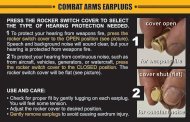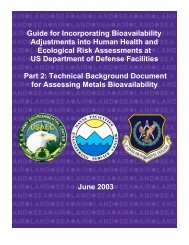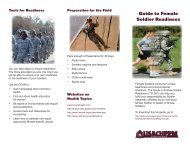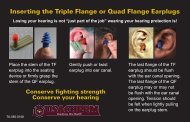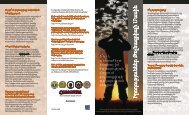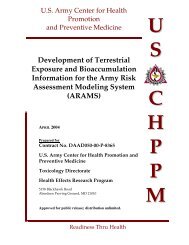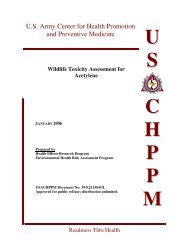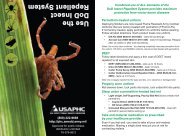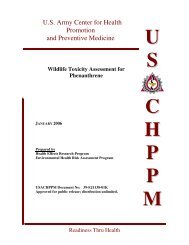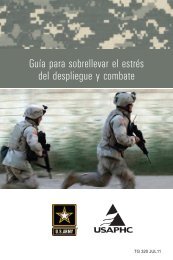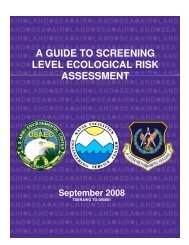Nitroglycerin - U.S. Army Public Health Command
Nitroglycerin - U.S. Army Public Health Command
Nitroglycerin - U.S. Army Public Health Command
You also want an ePaper? Increase the reach of your titles
YUMPU automatically turns print PDFs into web optimized ePapers that Google loves.
U.S. <strong>Army</strong> Center for <strong>Health</strong> Promotionand Preventive MedicineUSWildlife Toxicity Assessment forNITROGLYCERIN (NG)NOVEMBER 2007CHPrepared by<strong>Health</strong> Effects Research ProgramEnvironmental <strong>Health</strong> Risk Assessment ProgramPPUSACHPPM Document No: 37-EJ-1138-01FApproved for public release; distribution unlimited.MReadiness Thru <strong>Health</strong>
Wildlife Toxicity Assessment for<strong>Nitroglycerin</strong> (NG)NOVEMBER 2007Prepared by<strong>Health</strong> Effects Research ProgramEnvironmental <strong>Health</strong> Risk Assessment ProgramUSACHPPM Document No: 37-EJ-1138-01FApproved for public release; distribution unlimited.
WILDLIFE TOXICITY ASSESSMENT FOR NITROGLYCERINTable of Contents1. INTRODUCTION ................................................................................................................................52. TOXICITY PROFILE ..........................................................................................................................52.1 Literature Review..........................................................................................................................52.2 Environmental Fate and Transport................................................................................................62.3 Summary Of Mammalian Toxicology ..........................................................................................82.3.1 Mammalian Oral Toxicity ..................................................................................................92.3.1.1 Mammalian Oral Toxicity – Acute..................................................................................92.3.1.2 Mammalian Oral Toxicity – Subchronic .........................................................................92.3.1.3 Mammalian Oral Toxicity – Chronic ............................................................................102.3.1.4 Mammalian Oral Toxicity – Other ................................................................................122.3.1.5 Studies Relevant for Mammalian TRV Development for Ingestion Exposures............132.3.2 Mammalian Toxicity- Inhalation......................................................................................172.3.3 Mammalian Toxicity- Dermal ..........................................................................................172.4 Summary of Avian Toxicology...................................................................................................172.5 Summary of Reptile and Amphibian Toxicology .......................................................................173. RECOMMENDED TOXICITY REFERENCE VALUES.................................................................183.1 Toxicity Reference Values for Mammals ...................................................................................183.1.1 TRVs for Ingestion Exposures for the Class Mammalia ..................................................183.1.2 TRVs for Ingestion Exposures for Mammalian Foraging Guilds.....................................193.1.3 TRVs for Inhalation Exposures for the Class Mammalia.................................................193.1.4 TRVs for Dermal Exposures for the Class Mammalia.....................................................193.2 Toxicity Reference Values for Birds...........................................................................................193.3 Toxicity Reference Values for Reptiles and Amphibians...........................................................194. IMPORTANT RESEARCH NEEDS .................................................................................................205. REFERENCES ...................................................................................................................................21APPENDIX...............................................................................................................................................A-1Page 4 of 24
WILDLIFE TOXICITY ASSESSMENT FOR NITROGLYCERINDepartment of the <strong>Army</strong>U.S. <strong>Army</strong> Center for <strong>Health</strong> Promotion and Preventive MedicineWildlife Toxicity Assessment for <strong>Nitroglycerin</strong>CAS No. 55-63-0 November 20071. INTRODUCTIONThis Wildlife Toxicity Assessment (WTA) is based on a thorough review of the scientific literatureregarding the toxicological characteristics of nitroglycerin that may pertain to the health of wildlife(mammals, birds, reptiles and amphibians) exposed to the substance. The protocol for the performance ofthis assessment is documented in the U.S. <strong>Army</strong> Center for <strong>Health</strong> Promotion and Preventive MedicineTechnical Guide 254, the Standard Practice for Wildlife Toxicity Reference Values (USACHPPM 2000).This document is designed to support ecological risk assessment activities.2. TOXICITY PROFILE2.1 Literature Review<strong>Nitroglycerin</strong> (also known as trinitroglycerol or TNG) is produced for use as a component ofpropellants and explosives, and as a pharmaceutical agent. <strong>Nitroglycerin</strong> is a vasodilator widely used bythe medical community in the treatment of angina and other cardiovascular pathology (Gilman et al.1990, Burrows et al. 1989). There is an extensive body of literature related to the medical uses ofnitroglycerin. However, very few of these studies were found relevant to a WTA and the development ofwildlife toxicity values.Given the common military use of NG, several pertinent studies were found in U.S. <strong>Army</strong> andrelated sources. These military-related studies, and subsequent reports, were found through TOXLINE,Toxicology, Occupational Medicine Environmental Series (TOMES) and Defense Technical InformationCenter (DTIC) searches. In addition, relevant studies were found through traditional cross-referencingtechniques and through individual queries to project investigators within the <strong>Army</strong>. Several databaseswere searched; the details of these searches are found in Appendix A. An update of this review wasconducted in October 2007.Page 5 of 24
WILDLIFE TOXICITY ASSESSMENT FOR NITROGLYCERINTable 1. Table of Physical / Chemical Properties of <strong>Nitroglycerin</strong>CAS: 55-63-0Molecular weight 227.09Color Pale yellowState Viscous liquid; triclinic or rhombic crystals below meltingpointMelting point 13.5°C/2.8°C (labile form)Boiling point Apparently boils by decomposing rapidly at temperaturesabove 145°C; Explodes at 218-256°CTaste Sweet, burning tasteSolubility 1800 mg/L @ 25°C; soluble in acetone, benzene, andchloroform.Partition coefficientsLog K OW 1.62Log K OC 1.51 estimatedVapor pressure (at 20°C) 2.5E-04 mm HgHenry’s Law constant (at 20°C) Between 3.3 and 0.06 torr-l/moleOdor No informationConversion factors 1 ppm = 9.29 mg/m 31 mg/m 3 = 0.108 ppmSources: USEPA 1992, HSDB 2000, Lyman, W.J. et al. 1985, ACGIH 19912.2 Environmental Fate and Transport<strong>Nitroglycerin</strong> may be released to the environment from its production and use as a component ofpropellants and explosives and as a pharmaceutical compound. Wastewater discharges from themanufacture of commercial dynamite preparations, military explosives, and other production sources maycontain NG. The relatively high solubility of NG in water (1800 mg/L @ 20°C) suggests thatenvironmentally significant concentrations may be dissolved in waste rinse water and be expected toremain in the water column (USEPA 1992). Neat NG does not polymerize and exists as a stable solid inthe form of dipyramidal crystals at temperatures below 13.5°C. Liquid NG begins to decompose at 50 to60°C, and at 145°C decomposition is so rapid the liquid appears to boil. At 256°C NG explodesspontaneously (USEPA 1992).Page 6 of 24
WILDLIFE TOXICITY ASSESSMENT FOR NITROGLYCERINBoth abiotic and biotic processes influence the fate of NG released to the environment. Physical andchemical degradation of NG is generally slow (Smith 1986). The photolytic half-life of NG in pure waterwas estimated to be 5 days (Spanggord et al. 1980a), and the hydrolysis half-life of NG at normalenvironmental temperatures is predicted to be more than 1 year at pH 3 to 8 (Spanggord et al. 1980b). Analkaline environment significantly decreases the hydrolysis half-life of NG (Spanggord et al. 1980b).The kinetics and products formed on hydrolysis of NG and each of the isomeric dinitroglycerols(DNGs) and mononitroglycerols (MNGs) have been extensively studied. Chemical hydrolysis does notfollow the stepwise successively slower pathway found for microbial systems. Rather, NG hydrolyzesmore slowly than the DNGs or MNGs to a complex mixture of products, notably nitrate, nitrite, andoxalate. 1,3-DNG is hydrolyzed to glycidyl nitrate and 1,2-DNG isomerizes to 1,3-DNG to form asimilar product on hydrolysis. 2-MNG isomerized to 1-MNG before hydrolysis; the only productidentified was nitrate (Capellos et al. 1984).Nitrate and nitrite are highly mobile in soil and water and microbes can convert nitrate to nitrite,which can potentially cause methemoglobinemia in mammals. Plants may accumulate nitrates andingestion of plant material by ruminants (rumen microorganisms reduce nitrate to nitrite) may also resultin methemoglobinemia (Cockerham 1994). However, the production of hydrolysis products from NG isnot expected to be of concern to wildlife because the reaction will not proceed at any appreciable rateoutside of an environmentally extreme alkaline environment.Contrary to some earlier reports that it was recalcitrant to biodegradation, NG proved to be readilybiodegradable in batch and continuous tests. Breakdown of NG was found to take place in stages via theisomeric di- and mononitrates, with each successive step proceeding at a slower rate (Wendt et al. 1978,Walker and Kaplan 1992). It was found that NG is not suitable as a source of carbon and nitrogen sonutrients are essential. It was speculated that earlier experiments where NG did not biodegrade wereconducted using NG concentrations that were toxic to the microorganisms (Wendt et al. 1978, Smith1986, Burrows et al. 1989). In the environment, NG would likely be biotransformed through a series ofsuccessive denitration steps, and the products mineralized by biological systems and incorporated into thebiomass (Walker and Kaplan 1992).If released on land, NG may readily leach into the soil. Few experimental data are available on itsfate in the soil but biodegradation and hydrolysis under alkaline conditions are thought to occur. Few dataare available on the fate of NG released in aquatic environments; however, environmental degradation ofNG appears to occur primarily through biodegradation and photolysis. If released to the atmosphere, NGwill probably be in the form of an aerosol and be subject to gravitational settling and scouring by rain.Photolysis is considered a possibility but data are lacking. The Henry's Law constant calculated fromPage 7 of 24
WILDLIFE TOXICITY ASSESSMENT FOR NITROGLYCERINreported water solubilities and vapor pressures range between 3.3 and 0.06 torr-l/mole, resulting in a halflifefor volatilization from water of about 3000 days. Therefore, physical transport from aqueous systemsshould be relatively unimportant. <strong>Nitroglycerin</strong> is relatively soluble in water (1800 mg/L at 25°C) andtherefore adsorption to soil and sediment and bioconcentration in aquatic organisms should not beappreciable (HSDB 2000, Smith 1986, Spanggord et al. 1980b). Chemical/physical properties ofnitroglycerin are presented in Table 1.2.3 Summary of Mammalian Toxicology<strong>Nitroglycerin</strong> has profound effects on systemic as well as cardiac microcirculation. Its actions aremediated by stimulation of soluble guanylate cyclase in vascular smooth muscle cells. Long-termindustrial exposure to NG has been associated with withdrawal symptoms and sudden death fromcardiovascular accidents (Klaassen 1996).<strong>Nitroglycerin</strong> is rapidly absorbed, rapidly and widely distributed, and rapidly metabolized andeliminated in both laboratory animals and humans. Metabolism appears to occur in both hepatic andextrahepatic tissues via stepwise denitification; elimination is primarily in the urine and expired air.Absorption is somewhat less in mice than other species (Smith et al. 1986).Urinary metabolites in most species consisted largely of free MNGs, glycerol, and other polarmetabolites including glucuronides, while TNG and free DNGs were excreted only in small amounts.Mice excreted only small amounts of free MNG and DNG- and MNG-glucuronides indicating therelatively complete biotransformation in this animal species (USEPA 1992).<strong>Nitroglycerin</strong> is absorbed through intact skin in amounts sufficient to cause vasodilation. In humansthe most prominent manifestations of NG toxicity are severe headaches and adverse cardiovasculareffects, including organic nitrate dependence in the case of chronic exposure (Gilman et al. 1990). Inanimals, the adverse effect most often observed after administration of NG at high dosage levels isdecreased weight gain (related to decreased food consumption); effects were also seen in the liver(lesions), blood (methemoglobinemia), and testes (lesions and aspermatogenesis) (USEPA 1992).<strong>Nitroglycerin</strong> has not been shown to be genotoxic in either in vivo or in vitro studies. Developmentaland reproductive studies in animals have failed to demonstrate that NG is a teratogen. However, exposureto high concentrations of NG can result in testicular lesions and male infertility, and delayed developmentof offspring (Smith 1986).Page 8 of 24
WILDLIFE TOXICITY ASSESSMENT FOR NITROGLYCERIN2.3.1 Mammalian Oral Toxicity2.3.1.1 Mammalian Oral Toxicity – AcuteThe acute toxicity of NG in mammals is moderate. The oral LD 50 was reported to be approximately500-900 mg/kg in rats and 500-1200 mg/kg in mice (Lee et al. 1975, Oketani et al. 1982). Differences inthe acute toxicity of NG between sexes or among species appeared insignificant or minor.Charles River CD rats and Albino Swiss mice were administered NG in lactose/peanut oil by oralgavage and survivors observed for 14 days. The oral LD 50 was determined to be 822 and 884 mg/kg inmale and female rats, respectively, and 1188 and 1055 mg/kg in male and female mice, respectively. Allthe animals became cyanotic and ataxic within 1 hour of dosing, and had very pale extremities anddepressed respiration. Animals usually died within 5-6 hours of dosing; no gross pathology was observedin the animals that died. Survivors generally recovered within 24 hours (Lee et al. 1975). The number ofmale and female animals used in these studies was not provided.Oketani et al. (1982) administered NG in propylene glycol to S1c:dd mice and S1c:SD rats by oralgavage and observed the surviving animals for 7 days. Ten animals per sex were used in these studies.The LD 50 was 525 and 540 mg/kg for male and female rats, respectively, and 550 and 500 mg/kg for maleand female mice, respectively. Deaths occurred within 48 hours and survivors recovered within 48-72hours. There were no notable findings at autopsy (Oketani et al. 1982).Four groups of adult beagle dogs, each consisting of two males and two females were given 25, 50,100 or 200 mg/kg/day NG in capsules for 5 days. A transient and dose-related severemethemoglobinemia was observed. The 100 and 200 mg/kg/day group animals had cyanosis lasting forseveral hours. High dose dogs also exhibited decreased activity. Because of the severity of effects and tostudy any protective effect on methemoglobin formation, the high dose animals were given 3 mg/kgmethylene blue intravenously (to induce methemoglobin formation) on the 3 rd day and treatment wasdiscontinued thereafter. The two low dose groups had transient methemogobinemia and no adverseclinical effects (Lee et al. 1977, Ellis et al. 1984).2.3.1.2 Mammalian Oral Toxicity – SubchronicThirteen-week oral studies were conducted in dogs, rats, and mice as described in the followingparagraphs (Lee et al. 1977, Ellis et al. 1984). Because no adverse effects were observed during the firstseveral weeks of the 13-week studies, doses were increased 5-fold for dogs, rats, and mice starting the 5 th ,6 th , and 4 th week, respectively.<strong>Health</strong>y young adult beagle dogs, 4 males and 4 females per treatment group, were given 0, 0.01, 0.1or 1 mg/kg/day NG in capsules for 4 weeks, then 0, 0.05, 0.5 and 5 mg/kg/day for 9 more weeks. NoPage 9 of 24
WILDLIFE TOXICITY ASSESSMENT FOR NITROGLYCERINEllis et al. (1978a) conducted a series of cytogenic studies in dogs and rats in the chronic study. Inaddition, dominant lethal mutation studies were also conducted. There were no apparent NG-inducedmutagenic effects in the cytogenetics analyses of cells from dogs and rats and in the dominant lethalmutation study in rats.2.3.1.5 Studies Relevant for Mammalian TRV Development for Ingestion ExposuresThe relevant studies for development of Toxicity Reference Values (TRVs) are the chronic andsubchronic studies performed by Ellis et al. (1978a and 1984) and Lee et al. (1975 and 1977) in dogs, rats,and mice. These studies were conducted properly, containing the information necessary to evaluate theresults, and reported results in a clear, logical, concise form. The methods used were consistent withother accepted protocols and contained the proper controls. These studies, therefore, meet or exceed theminimum quality requirements. The chronic studies were considered most relevant both because of theexposure duration and because the dose levels changed during the subchronic studies. This results inNOAEL and LOAEL values that are less certain. Acute studies provided additional information but werenot considered applicable to the development of a TRV. The studies by Suzuki et al. (1975) and Oketaniet al. (1982) were included as informational data points but were not used to derive a TRV, because thesedata were from a secondary reference and an English version of the original work could not be obtained.Table 2 summarizes the data from these studies and Figure 1 presents the data in a scatter diagram.Page 13 of 24
WILDLIFE TOXICITY ASSESSMENT FOR NITROGLYCERINFigure 1NITROGLYCERIN HEALTH EFFECTS IN MAMMALSHEALTH EFFECTS vs LD50HEALTH EFFECTS vs LOAELHEALTH EFFECTS vs NOAEL100001000m1r1m3,4m3,4mg/kg/day100r3,4m3,4d1,2d1,2r3,4d3,4r3,4m3,4r3,4 r3,4r3,4r2,4r3,4r2,4r2,4m3,4r3,4d2,4m3,4d2,4r3,4r3,4r3,4 r3,4LOAEL-Based TRVr2,410m3,4m3,4r3,4r3,4d2,4NOAEL-Based TRV1MORTALITYHEMATOLOGICPATHOLOGYBIOCHEMICALGROWTHBEHAVIORALREPRODUCTIVEOTHER1 = Lee et al. 19752 = Lee et al. 19773 = Ellis et al. 19784 = Ellis et al. 1984HEALTH EFFECTSRAT = rMOUSE = mDOG = dPage 16 of 24
WILDLIFE TOXICITY ASSESSMENT FOR NITROGLYCERIN3. RECOMMENDED TOXICITY REFERENCE VALUES 13.1 Toxicity Reference Values for Mammals3.1.1 TRVs for Ingestion Exposures for the Class MammaliaThree species of mammals from two different orders were evaluated using dietary exposures ofTNG. The data set contains studies that are comprehensive in the scope of potential effects and in studyduration. Moreover, most studies were well documented and contain refined data from all observations.Thus, these studies are considered to be of acceptable quality to derive a TRV.Most studies have consistent and corroborative findings. Incidences of indicators that suggest livernecrosis, red blood cell lysis, methemoglobinemia, adverse reproductive effects, and weight loss erereported within the same ranges. Many studies conducted at relatively low levels failed to find adverseeffects. Although some findings (e.g., transient and reversible methemoglobinemia) have questionablebiological and ecological significance, other effects (e.g., reduced male fertility) are clearly important.Given that most of these data follow a consistent pattern, and that the reproductive data are notappropriate for benchmark dose extrapolation, the NOAEL-LOAEL approach was used.The NOAEL-based TRV was based on the chronic study by Ellis et al. (1978a) where no adverseeffects in weight loss or hepatic lesions were observed. Therefore, the NOAEL was derived from themost sensitive species (rat) and sex tested (males) at 3 mg/kg/d.The LOAEL-based TRV was derived from the original Ellis et al (1978a) work where at 31.5mg/kg/d mild hepatic lesions and incidences of weight loss were found in chronically exposed male rats.Therefore, the LOAEL-based TRV of 32 mg/kg/d was selected. This value less than those where otherendpoints (e.g., reproductive) were observed and therefore protective of other reported effects.Because the relevant data, as presented in Section 2.3.1.5, satisfies the minimum data setrequirement of the Standard Practice (USACHPPM 2000), no uncertainty factors are needed to select theTRVs.The studies used to derive the LOAEL-based TRV were chronic and the results are consistent withthose of other studies, thus this TRV is given a High degree of confidence. The NOAEL-based TRV was1 TRVs are for screening purposes only and are not intended to be predictors of effects in field situations. Sitespecific conditions may justify adjustments of these values based on toxicity information relevant to specificassessment endpoints.Page 18 of 24
WILDLIFE TOXICITY ASSESSMENT FOR NITROGLYCERINderived from a chronic study that evaluated consistent endpoints of toxicity. However, given theinformation present in other studies where higher doses were tested in between these of Ellis et al. whereno adverse effects were observed, it is likely that the true NOAEL for many species of mammals is likelyto be higher. Therefore, the NOAEL-based TRV is given a Medium degree of confidence. See Table 3for a summary of mammalian TRVs.Table 3. TRVs for the Class MammaliaTRV Dose ConfidenceNOAEL-based 3.0 mg/kg/d MediumLOAEL-based 32.0 mg/kg/d Highderived.3.1.2 TRVs for Ingestion Exposures for Mammalian Foraging GuildsTRVs specific to particular guild associations (e.g., small herbivorous mammals) have not yet been3.1.3 TRVs for Inhalation Exposures for the Class MammaliaAt this time, no inhalation TRV can be derived for mammals due to insufficient data.3.1.4 TRVs for Dermal Exposures for the Class MammaliaAt this time, no dermal TRV can be derived for mammals due to insufficient data. However, giventhat there is evidence that NG has irritant and sensitizing properties, and that dermal exposures have beenidentified as significant, the dermal route of exposure should be considered for risk assessment purposes.3.2 Toxicity Reference Values for BirdsSince no adverse effects were found in Northern Bobwhite exposed to concentration of nitroglyceringreater than 5000 ppm for eight days, nitroglycerin is considered to be non-toxic in environmentalsettings.3.3 Toxicity Reference Values for AmphibiansAt this time no TRVs for reptiles and amphibians can be derived due to the lack of data.Page 19 of 24
WILDLIFE TOXICITY ASSESSMENT FOR NITROGLYCERIN3.4 Toxicity Reference Values for ReptilesAt this time no TRVs for reptiles and reptiles can be derived due to the lack of data.4. IMPORTANT RESEARCH NEEDSThe effects of NG have not been assessed in amphibian, or reptilian animal systems. It isrecommended that these effects be evaluated.Page 20 of 24
WILDLIFE TOXICITY ASSESSMENT FOR NITROGLYCERIN5. REFERENCESAmerican Conference of Governmental Industrial Hygienists (ACGIH). 1991. Documentation of theThreshold Limit Values and Biological Exposure Indices, 6 th Edition: <strong>Nitroglycerin</strong>. ACGIH, Inc.,Cincinnati, OH.Burrows, E. P, D. H. Rosenblatt, W. R. Mitchell, and D. L. Parmer. 1989. Organic explosives and relatedcompounds: environmental and health considerations. Technical Report No. AD –8901. U. S. <strong>Army</strong>Biomedical Research and Development Laboratory, Ft. Detrick, Frederick, MD.Capellos, C., W. J. Fisco, C. Ribaudo, V.D. Hogan, J. Campisi,, F.X. Murphy, T.C. Castorina, and D.H.Rosenblatt. 1984. International Journal of Chemical Kinetics, 16: 1009-1051 in Burrows et al.(1989).Cockerham, L.G and B.S. Stone. (Eds.). 1994. Basic Environmental Toxicology. pp. 275, 337. CRCPress, Boca Raton, FL.Dacre, J.C, C. C. Lee, H.V. Ellis, III, and C. B. Hong. 1980. Chronic and carcinogenic study oftrinitroglycerin in rats, mice and dogs. Arch. Toxicol. Suppl. 4: 88.Ellis, H.V, J.H. Hagensen, J.R. Hodgson, J.L. Minor, C.B. Hong, E.R. Ellis, J.D. Girvin, D.O. Helton,B.L. Herndon, and C.C. Lee. 1978a. Mammalian Toxicity of munitions compounds. Phase III.Effects of lifetime exposure. Part II: Trinitroglycerin. Progress Report No. 8. AD A078746/5.Midwest Research Institute, Kansas City, MO DAMD-17-74-C-4073.Ellis, H.V, III, J.R. Hodgson, S.W. Hwang, L.M. Halpap, D.O. Helton, B.S. Anderson, D.L. VanGoethem, and C.C. Lee. 1978b. Mammalian Toxicity of munitions compounds. Phase I: Acute oraltoxicity, primary skin and eye irritation, dermal sensitization, disposition and metabolism, and Amestests of additional compounds. Report No. 6. AD A069333. Midwest Research Institute, KansasCity, MO. DAMD-17-74-C-4073.Ellis, H.S., III, C.B. Hong, C.C. Lee, J.C. Dacre, and J.P. Glennon. 1984. Subacute and chronic toxicitystudies of trinitroglycerin in dogs, rats, and mice. Fundam. Appl. Toxicol. 4: 248-260.Page 21 of 24
WILDLIFE TOXICITY ASSESSMENT FOR NITROGLYCERINFink, R., J.B. Beavers, G. Joiner, J. Faulcon, V. Cadby, J. Beskid, M. Anthony, N. Tiller, and R. Brown.1980. Eight-day Dietary LC50-Bobwhite Quail. Final Report. Wildlife International, Ltd. Preparedfor Hercules Inc, Wilmington, DE.Gilman, A.G., T.W. Rall, A.S. Nies, and P. Taylor. (Eds.). 1990. The Pharmacological Basis ofTherapeutics, 8 th Edition, pp. 764-774. Pergamon Press, New York.Hazardous Substance Data Base (HSDB). 2000. Tomes Database/Micromedix Inc., National Library ofMedicine, Bethesda, MD.Klaassen, C.D. (Ed.). 1996. Casarett and Doull’s Toxicology: the Basic Science of Poisons, 5 th Edition,p. 524. McGraw-Hill, New York.Lee, C.C., J.V. Dilley, J.R. Hodgson, D.O. Helton, W.J. Wiegand, D.N. Roberts, B.S. Anderson, L.M.Halfpap, L.D. Kurtz, and N. West. 1975. Mammalian toxicity of munition compounds. Phase I.Acute oral toxicity, primary skin and eye irritation, dermal sensitization and disposition andmetabolism. Report No. 1 AD B011150. Midwest Research Institute, Kansas City, MO DAMD-17-74-C-4073.Lee, C.C., H.V. Ellis, III, J.J. Kowalski, J.R. Hodgson, S.W. Hwang, R.D. Short, J.C. Bhandari, J.L.Sanyer, T.W. Reddig, J.L. Minor, and D.O. Helton. 1977. Mammalian toxicity of munitioncompounds. Phase II: Effects of multiple doses. Part I: Trinitroglycerin, Progress Report No. 2ADA 047067. Midwest Research Institute, Kansas City, MO.Lyman, W.J., W.F. Reehl, D.H. Rosenblatt. 1985. Handbook of chemical property estimation methods.McGraw-Hill, New York.Oketani, Y., T. Mitsuzono, K. Ichikawa, Y. Itono, T. Gojo, S. Nagayoshi, and N. Konoha. 1982.Toxicological studies on nitroglycerin (NK-843). 1. Acute toxicity in mouse and rat. IyakuhinKenkyu 13: 90-94 in Smith (1986).Rosenblatt, D.H., E.P. Burrows, W.R. Mitchell, and D.L. Parmer. 1991. Organic explosives and relatedcompounds. U.S. <strong>Army</strong> Biomedical Research and Development Laboratory, Fort Detrick, MD. In:Page 22 of 24
WILDLIFE TOXICITY ASSESSMENT FOR NITROGLYCERINThe Handbook of Environmental Chemistry, Vol 3, Part G, Ed. O. Hutzinger, Springer-Verlag,Berlin.Smith, J.G. 1986. Water quality criteria for nitroglycerin: final report. Oak Ridge National Laboratory,Oak Ridge, TN.Spanggord, R.J., T. Mill, T.W. Chou, W.R. Mabey, J.H. Smith, and S. Lee. 1980a, in Smith (1986).Environmental fate studies on certain munition wastewater constituents, final report, Phase II-Laboratory studies. SRI International, Menlo Park, CA. Supported by U. S. <strong>Army</strong> MedicalResearch and Development <strong>Command</strong>, Fort Detrick, MD.Spanggord, R.J., T. Mill, T.W. Chou, W.R. Mabey, J.H. Smith, and S. Lee. 1980b. Environmental fatestudies on certain munition wastewater constituents, final report, Phase I-Literature Review. SRIInternational, Menlo Park, CA. Supported by U. S. <strong>Army</strong> Medical Research and Development<strong>Command</strong>, Fort Detrick, MD.Suzuki, K., K. Sudo, T. Yamamoto, and K. Hashimoto. 1975. The carcinogenicity of N-ethocarbonyl-3-morpholinosydnonimine (molsidomine) in comparison with nitroglycerin in C57BL6jms mice.Pharmacometrics 9: 229-242 in Smith (1989).U.S. <strong>Army</strong> Center for <strong>Health</strong> Promotion and Preventive Medicine(USACHPPM). 2000. StandardPractice for Wildlife Toxicity Reference Values, Technical Guide 254 Environmental <strong>Health</strong> RiskAssessment Program and <strong>Health</strong> Effects Research Program, Aberdeen Proving Ground, MD.October 2000U.S. Environmental Protection Agency (USEPA). 1992. Drinking water heath advisory: munitions –trinitroglycerol (TNG). USEPA Office of Drinking Water <strong>Health</strong> Advisories, Roberts, WC andHartley, W.R, Eds. Lewis Publishers, Boca Raton, LA.Walker, J.E. and D.L. Kaplan. 1992. Biological degradation of explosives and chemical agents. U.S.<strong>Army</strong> Natick Research, Development and Engineering Center, Natick, MA.Page 23 of 24
WILDLIFE TOXICITY ASSESSMENT FOR NITROGLYCERINWendt, T.M., J.H. Cornell, and A.M. Kaplan. 1978. Microbial degradation of glycerol nitrates. AppliedEnvironmental Microbiology 36: 693-699.Wester, R.C, P.K. Noonan, S. Smeach, and L. Kosobud. 1983. Pharmacokinetics and bioavailibility ofintravenuos and topical nitroglycerin in the rhesus monkey: estimate of percutaneous first passmetabolism. Journal of Pharmaceutical Sciences, Vol. 72, No. 7: 745-748.Page 24 of 24
WILDLIFE TOXICITY ASSESSMENT FOR NITROGLYCERINAPPENDIX ALITERATURE REVIEWThe following databases were searched using the following keywords:TOXLINE & MEDLINEConditions: Two-word search; 1965 to present.<strong>Nitroglycerin</strong> and mammals - <strong>Nitroglycerin</strong> = 1938Mammals = 29485Combination = 448Of these, 6 were appropriate and included.<strong>Nitroglycerin</strong> and birds - <strong>Nitroglycerin</strong> = 1938Birds = 12127Combination = 1After review of the title, the single query result was not appropriate for this document.<strong>Nitroglycerin</strong> and wildlife - <strong>Nitroglycerin</strong> = 1938Wildlife = 12029Combination = 0<strong>Nitroglycerin</strong> and salamanders - <strong>Nitroglycerin</strong> = 1938Salamanders = 425Combination = 0<strong>Nitroglycerin</strong>e and toads - <strong>Nitroglycerin</strong> = 911Toad = 411Combination = 0Appendix A/Page 1



